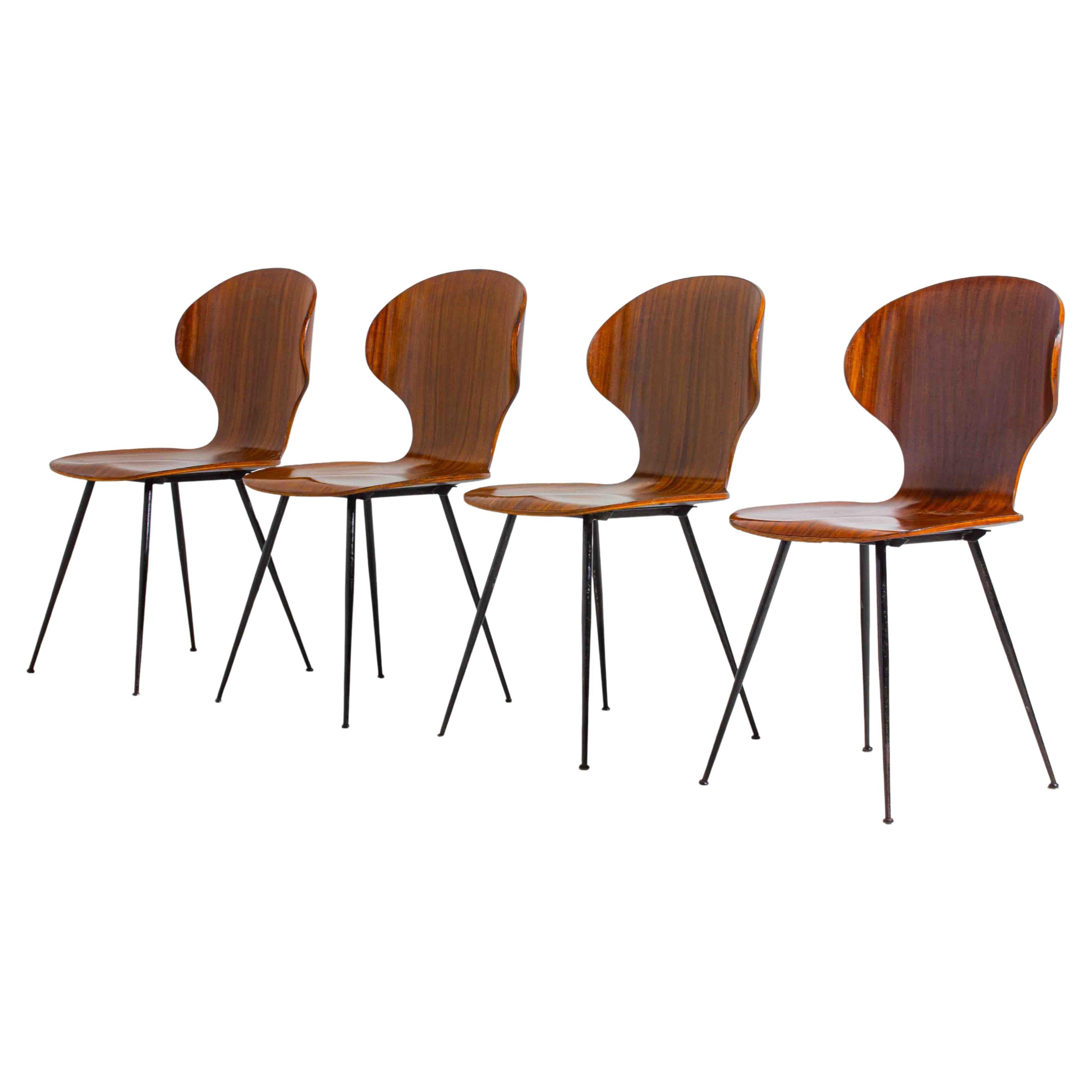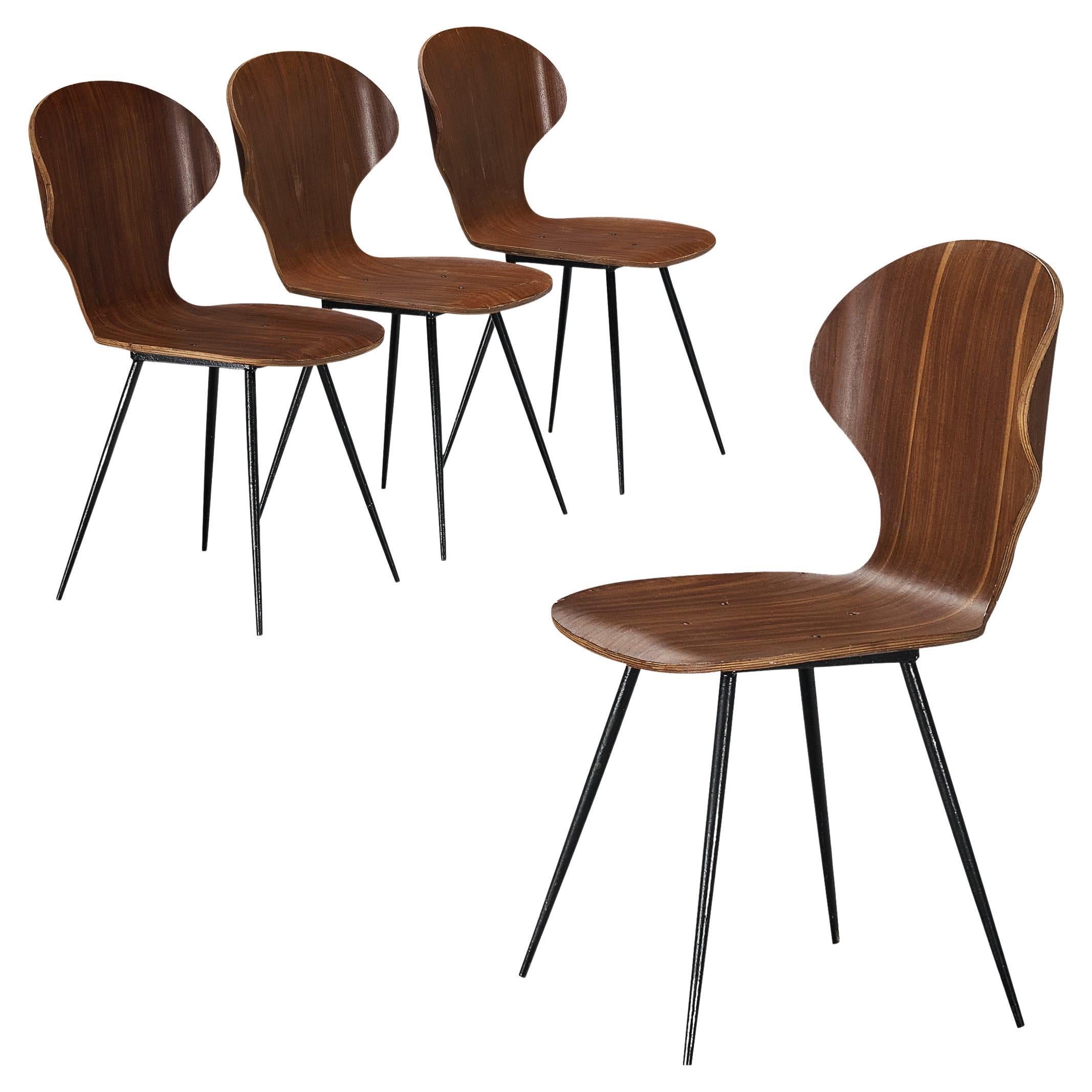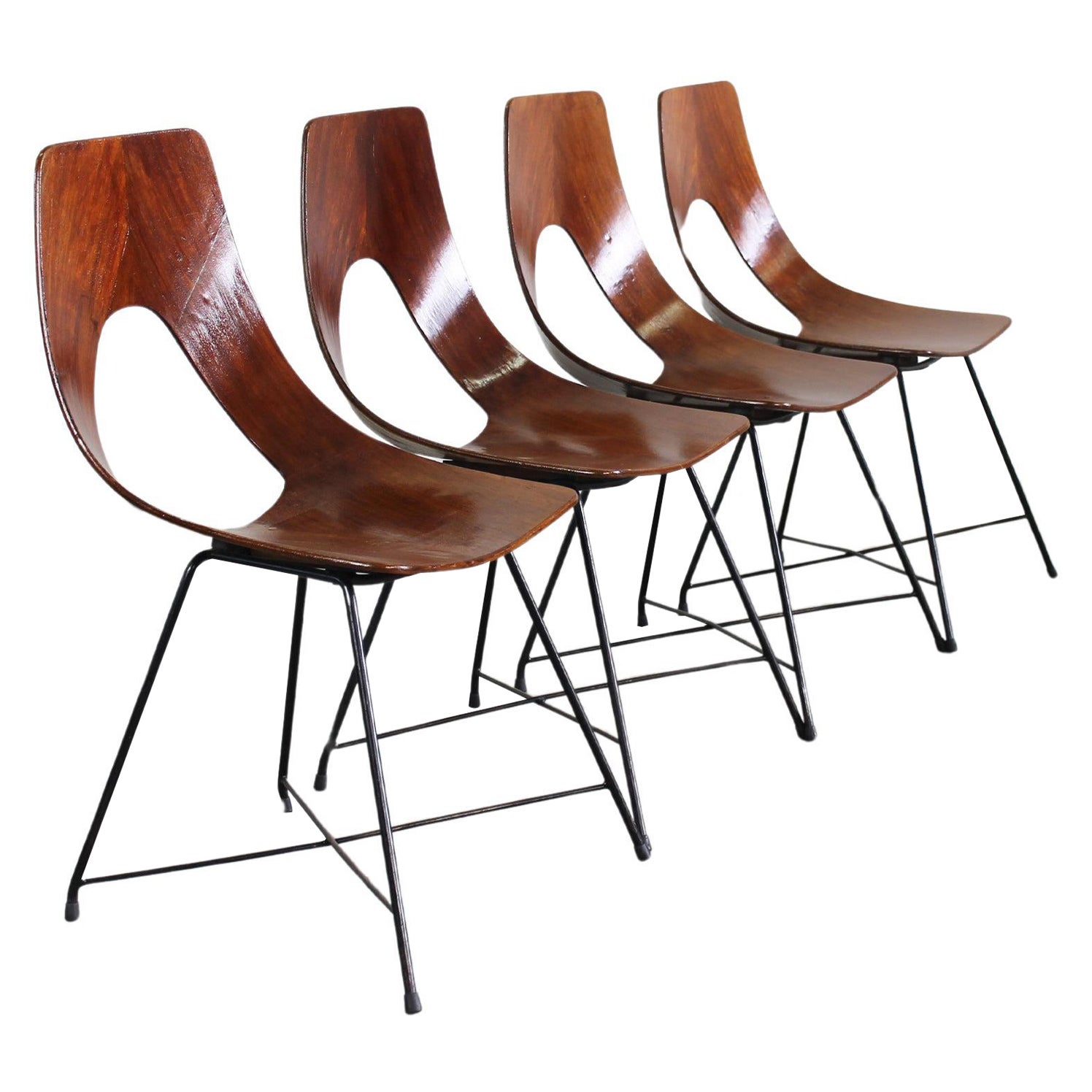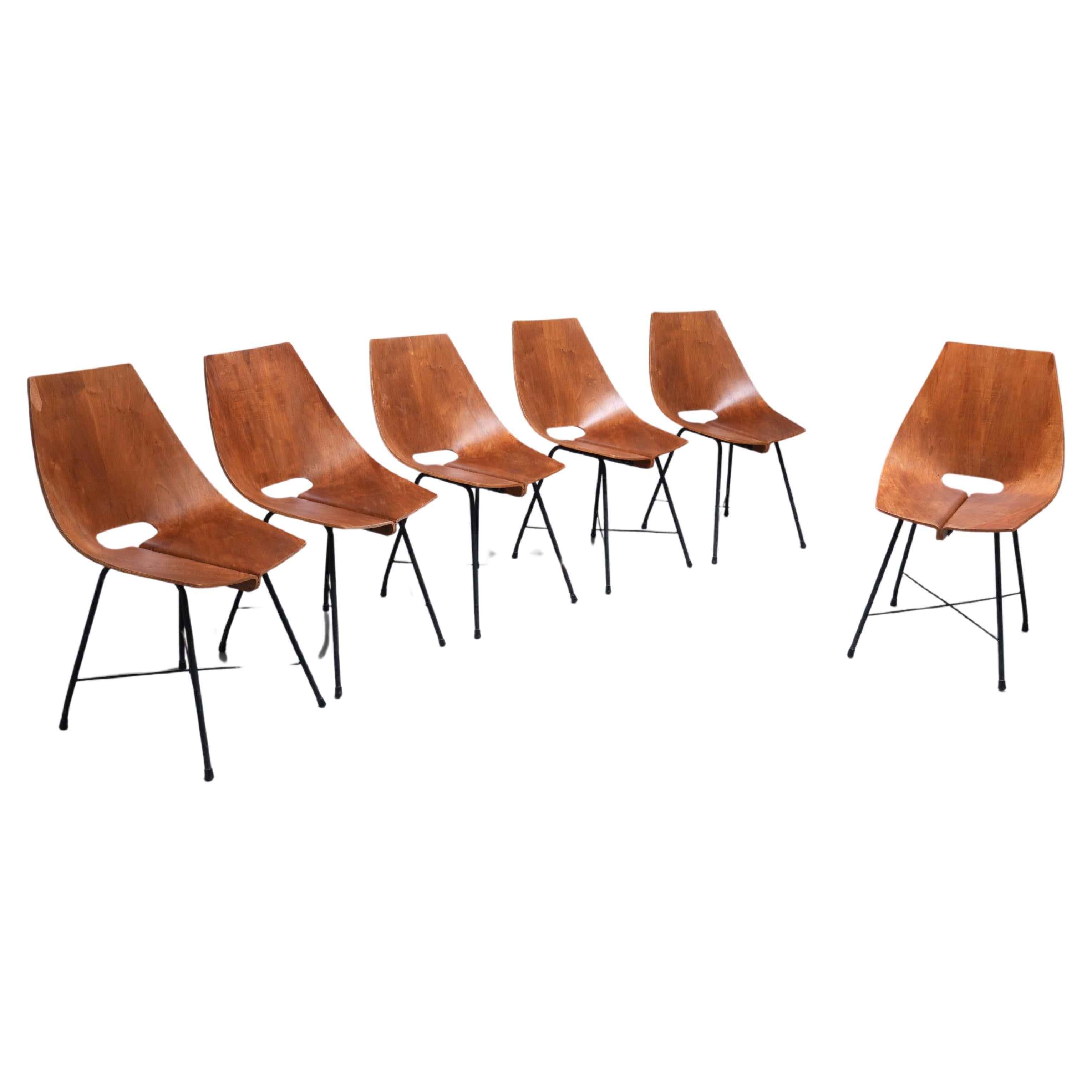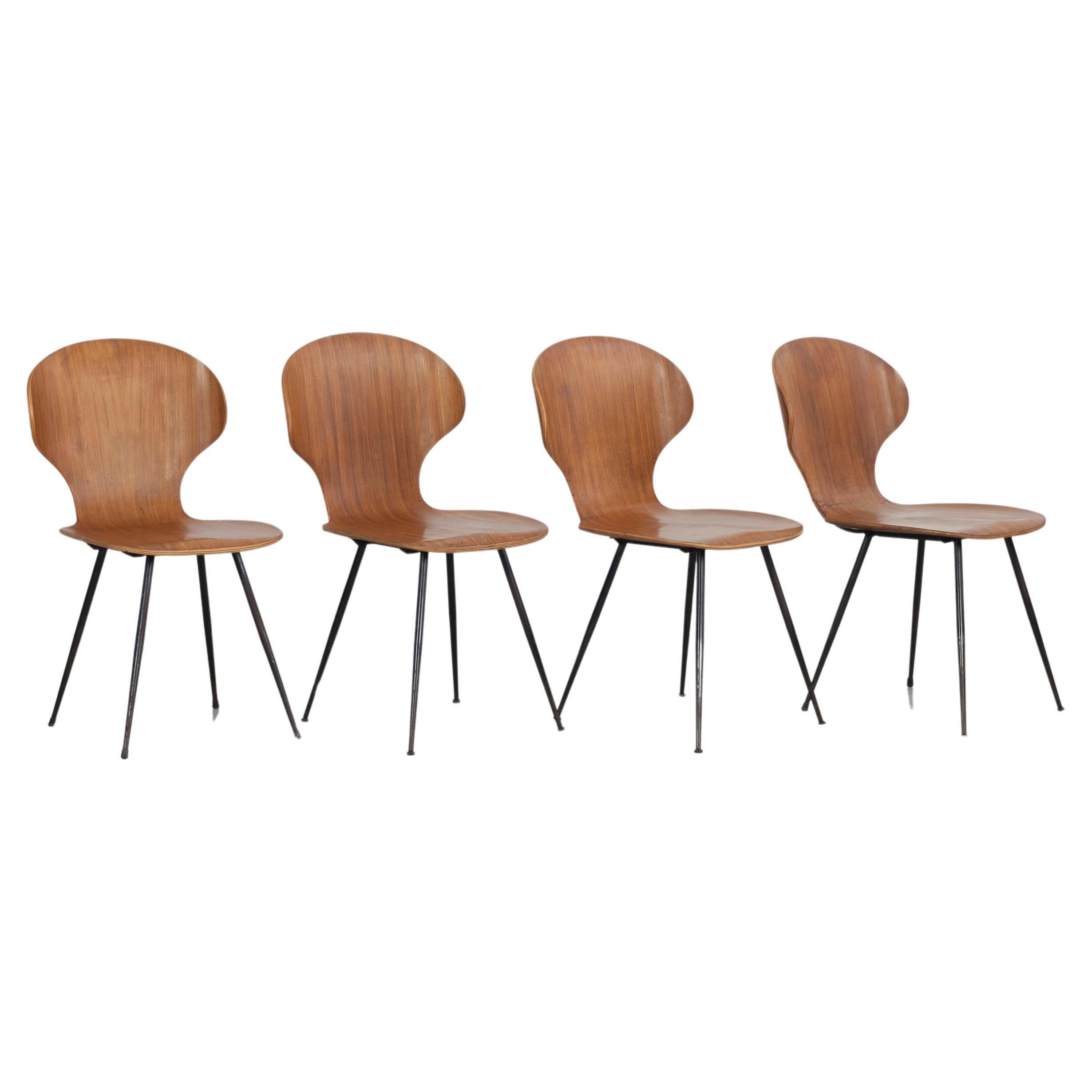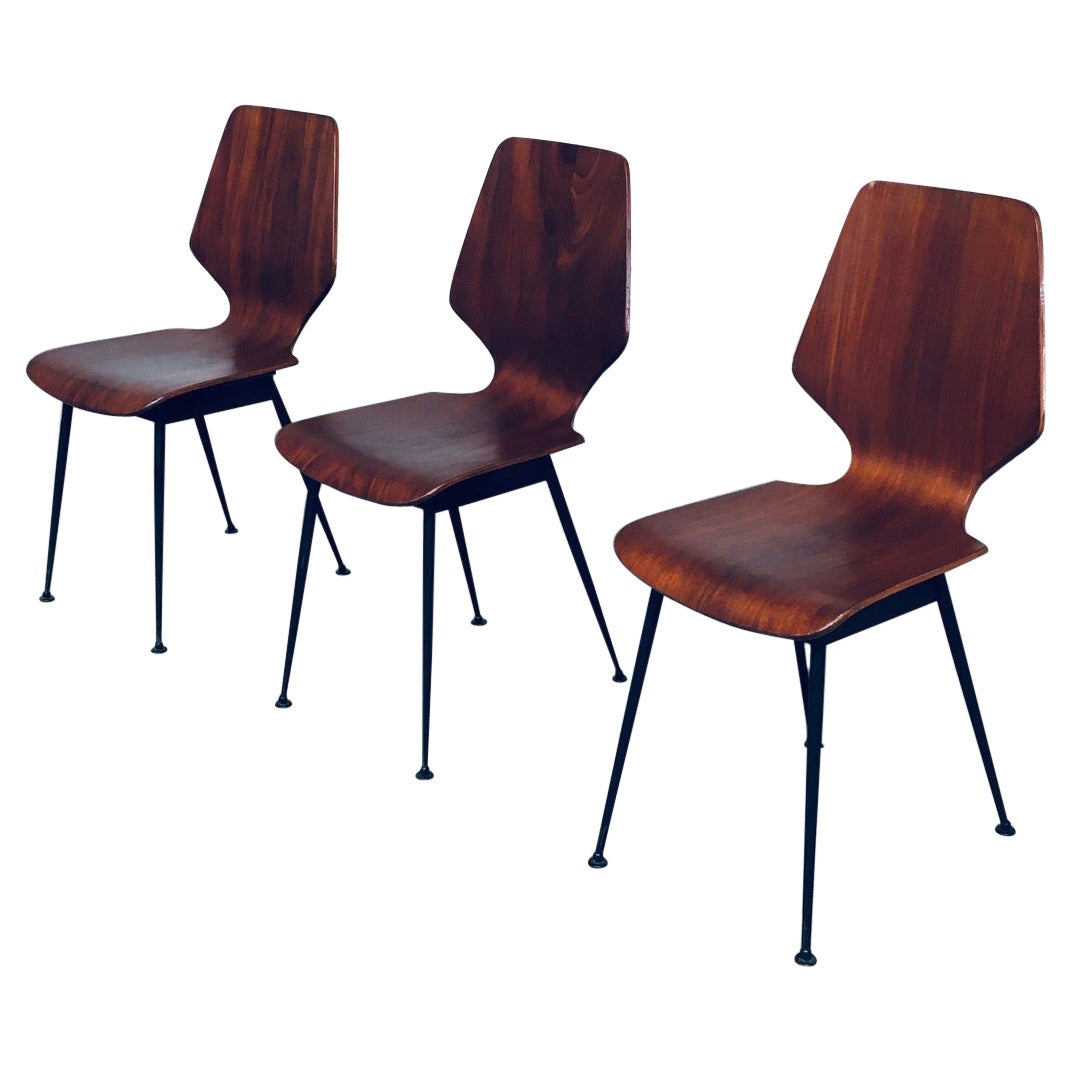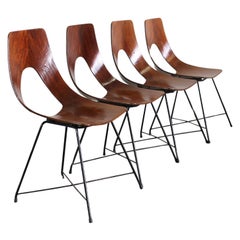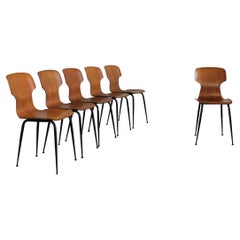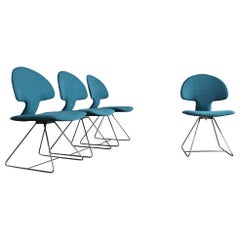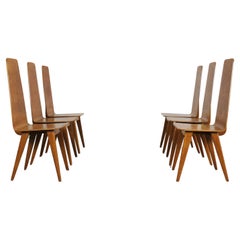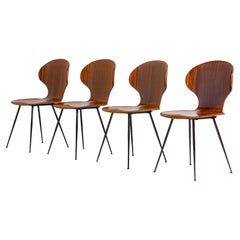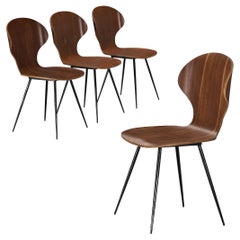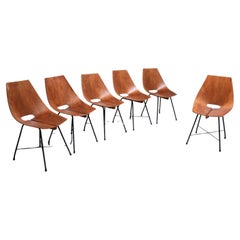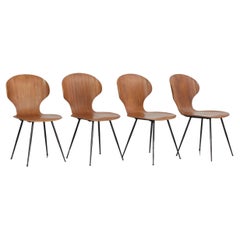Items Similar to Carlo Ratti Set of Four Chairs in Plywood by Società Compensati Curvi 1950s
Want more images or videos?
Request additional images or videos from the seller
1 of 9
Carlo Ratti Set of Four Chairs in Plywood by Società Compensati Curvi 1950s
$7,423.86per set
£5,487.87per set
€6,200per set
CA$10,096.96per set
A$11,313.59per set
CHF 5,889.15per set
MX$138,404.38per set
NOK 74,751.92per set
SEK 70,602.29per set
DKK 47,209.96per set
Shipping
Retrieving quote...The 1stDibs Promise:
Authenticity Guarantee,
Money-Back Guarantee,
24-Hour Cancellation
About the Item
Set of four dining chairs with a frame in black lacquered metal and seat in curved plywood, attributed to Carlo Ratti and produced by Società Compensati Curvati in the 1950s.
In Italy, at the beginning of the XX century, industries of curved solid wood arose under license of Michael Thonet, and through the International Exhibitions the processing of curved wood became more and more widespread.
The Expo of the first decade was also attended by the wood manufacturers of Monza, while in 1905 Otto Helzer, in Switzerland, patented wooden structures in curved laminated, whose strength was equivalent to those in steel.
The Ratti brothers of Monza took their cue from the solid wood laminate to create furniture that, instead of wooden elements, used sheets of wood.
The brothers Ratti, Carlo and Mario, also began to follow the young artistic avant-gardes (cubism, futurism and abstractionism).
The mastery of wooden sculpture influenced Carlo in the design and realization of furniture of fine neo-plastic artistic workmanship and decò, receiving honors from the Prince of Piedmont Umberto di Savoia.
In 1919, in Milan, the first Lombard Exhibition of Decorative Arts was set up (later to become the Triennale) and the Ratti brothers exhibited their furniture in solid wood but also in curved panel with a new system of curvature, the one in Telo.
The canvas system was developed by the Ratti brothers with the help of a friend, Cesare Cantù.
They developed an elastomer bag in which the mould was inserted with the panel to be bent and, closing it with clamps, the air inside was removed, thus making the panel adhere to the mould.
Carlo and Mario found in the Telo system a means by which they could make objects and furniture in the three spatial directions with large surface curvatures, without limits of thickness and minimum radii of curvature.
In 1921 in Stuttgart the first Salone del Mobile was inaugurated and the Fratelli Ratti of Monza made itself known internationally by presenting solid wood furniture and also furniture in load-bearing plywood, flanked by furniture with framed and interchangeable covers.
The Expo became meeting places to verify and present the novelties in the furniture and industrialization sector and, with the development of Industrial Design, the first architects joined in the design of the furniture industries.
The Ratti Brothers, in the various international and national exhibitions, also presented incredible objects in their realization with the system in Telo.
After 1930 Carlo and Mario produced many containers for radio and folding chairs for cinema but in 1939 they divided and in Monza Mario remained who, with his sons Antonio and Angela, formed the Società Compensati Curvi.
Carlo moved to Lissone, forming with his sons Angelo and Piera and with her husband, Piero Berruti, the Industria Legni Curvati. After the war, a new bending system, the Mould and Counter-mould, was added to the existing systems from the 1950s.
After the war, the architects devoted themselves exclusively to the planning and reconstruction of the territory and the need to regain the markets put the industrialists in conditions to offer quality products, designed by architects-designers of the new generation.
Both Carlo Ratti’s and Mario’s firm began collaborating with world-famous architects such as Ignazio Gardella, Paolo Chessa, Vico Magistretti, the Castiglioni brothers, Vittoriano Vigano, Marco Zanuso, Carlo de Carli, etc.
In those years many technological objects were made with curved plywood bodies such as washing machines, televisions, radios, sewing machines, etc. while the production of furniture in a rationalistic style continued.
The new bending technologies, Mould and Counter-mould and High Frequency, allowed a remarkable mass production and, if the old system in Telo continued to exist to make extraordinary objects with Coons curves, especially the High Frequency spread all over the world.
The Japanese company Tendo Mokko invented this new bending system in 1948, trying to make plywood planes and, immediately, the company Ratti of Monza used it, while that of Lissone continued to make products with the old Mould and Counter-mould system.
This system used aluminum shapes unlike other systems that, instead, made wooden shapes, with considerable economic savings.
In 1954 a chair designed by Carlo de Carli for Cassina and made by Carlo Ratti won the "Compasso d'Oro" award as an object of considerable technical and aesthetic value.
In 1961 Carlo Ratti died and his sons Angelo and Piera, with her husband Piero Berruti, continued the activity while the third generation was entering the company.
The company transformed from Industria Legni Curvati into Carlo Ratti s.a.s and, since then, new collaborations with young architects allowed a new technological development.
Thus, the High Frequency system was introduced in the company, but the Mould and Counter-mould system was not abandoned and, above all, the Telo system that was still used for the production of samples and prototypes.
- Creator:Società Compensati Curvati (Manufacturer)
- Attributed to:Carlo Ratti (Designer)
- Dimensions:Height: 31.5 in (80 cm)Width: 19.69 in (50 cm)Depth: 17.72 in (45 cm)
- Sold As:Set of 4
- Style:Mid-Century Modern (Of the Period)
- Materials and Techniques:
- Place of Origin:
- Period:
- Date of Manufacture:1950s
- Condition:Wear consistent with age and use.
- Seller Location:Montecatini Terme, IT
- Reference Number:1stDibs: LU5304223682922
About the Seller
4.9
Vetted Professional Seller
Every seller passes strict standards for authenticity and reliability
1stDibs seller since 2020
123 sales on 1stDibs
Typical response time: 1 hour
- ShippingRetrieving quote...Shipping from: Florence, Italy
- Return Policy
Authenticity Guarantee
In the unlikely event there’s an issue with an item’s authenticity, contact us within 1 year for a full refund. DetailsMoney-Back Guarantee
If your item is not as described, is damaged in transit, or does not arrive, contact us within 7 days for a full refund. Details24-Hour Cancellation
You have a 24-hour grace period in which to reconsider your purchase, with no questions asked.Vetted Professional Sellers
Our world-class sellers must adhere to strict standards for service and quality, maintaining the integrity of our listings.Price-Match Guarantee
If you find that a seller listed the same item for a lower price elsewhere, we’ll match it.Trusted Global Delivery
Our best-in-class carrier network provides specialized shipping options worldwide, including custom delivery.More From This Seller
View AllAugusto Bozzi Set of Four Ariston Chairs in Plywood and Metal by Saporiti 1950s
By Augusto Bozzi, Fratelli Saporiti
Located in Montecatini Terme, IT
Set of four dining chairs model Ariston with structure in curved plywood and black lacquered metal legs.
The Ariston chair was designed by Augusto Bozzi and manufactured by Saporiti...
Category
Vintage 1950s Italian Mid-Century Modern Chairs
Materials
Metal
Carlo Ratti Set of Six Chairs in Plywood by Industria Legni Curvati Lissone 1950
By Carlo Ratti, Industria Legni Curvati
Located in Montecatini Terme, IT
Set of six dining chairs with backs and seats realized in curved veneered plywood and legs in black lacquered metal, designed by Carlo Ratti and manufactured by Industria Legni Curvati (Lissone, Italy) in the 1950s.
In Italy, at the beginning of the XX century, industries of curved solid wood arose under license of Michael Thonet, and through the International Exhibitions the processing of curved wood became more and more widespread.
The Expo of the first decade was also attended by the wood manufacturers of Monza, while in 1905 Otto Helzer, in Switzerland, patented wooden structures in curved laminated, whose strength was equivalent to those in steel.
The Ratti brothers of Monza took their cue from the solid wood laminate to create furniture that, instead of wooden elements, used sheets of wood.
The brothers Ratti, Carlo and Mario, also began to follow the young artistic avant-gardes (cubism, futurism and abstractionism).
The mastery of wooden sculpture influenced Carlo in the design and realization of furniture of fine neo-plastic artistic workmanship and decò, receiving honors from the Prince of Piedmont Umberto di Savoia.
In 1919, in Milan, the first Lombard Exhibition of Decorative Arts was set up (later to become the Triennale) and the Ratti brothers exhibited their furniture in solid wood but also in curved panel with a new system of curvature, the one in Telo.
The canvas system was developed by the Ratti brothers with the help of a friend, Cesare Cantù.
They developed an elastomer bag in which the mould was inserted with the panel to be bent and, closing it with clamps, the air inside was removed, thus making the panel adhere to the mould.
Carlo and Mario found in the Telo system a means by which they could make objects and furniture in the three spatial directions with large surface curvatures, without limits of thickness and minimum radii of curvature.
In 1921 in Stuttgart the first Salone del Mobile was inaugurated and the Fratelli Ratti of Monza made itself known internationally by presenting solid wood furniture and also furniture in load-bearing plywood, flanked by furniture with framed and interchangeable covers.
The Expo became meeting places to verify and present the novelties in the furniture and industrialization sector and, with the development of Industrial Design, the first architects joined in the design of the furniture industries.
The Ratti Brothers, in the various international and national exhibitions, also presented incredible objects in their realization with the system in Telo.
After 1930 Carlo and Mario produced many containers for radio and folding chairs for cinema but in 1939 they divided and in Monza Mario remained who, with his sons Antonio and Angela, formed the Società Compensati Curvi...
Category
Vintage 1950s Italian Mid-Century Modern Chairs
Materials
Metal
Vittorio Introini Set of Four Longobarda Dining Chairs by Saporiti 1960s Italy
By Vittorio Introini, Saporiti
Located in Montecatini Terme, IT
Set of four Longobarda chairs with chromed metal legs, seat, and back upholstered with blue shade fabric.
The Longobarda chair was designed by Vittorio Introini and manufactured by ...
Category
Vintage 1960s Italian Mid-Century Modern Chairs
Materials
Metal
Set of Six Dining Chairs in Wood by Sineo Gemignani Italian Manufacture 1940s
By Sineo Gemignani
Located in Montecatini Terme, IT
A very rare set of six dining chairs entirely made in curved wood, this set was designed by the Italian artist Sineo Gemignani and manufactured in Ital...
Category
Vintage 1940s Italian Mid-Century Modern Chairs
Materials
Wood
Gio Ponti (Attributed to) Set of Five Chairs in Wood and Leather by ISA Bergamo
By Gio Ponti, I.S.A. Italy
Located in Montecatini Terme, IT
A set of five dining chairs with a structure in wood, seat, and back in padded leather, produced by the Italian manufacturer ISA Bergamo the design of this set is attributed to Gio P...
Category
Vintage 1950s Italian Mid-Century Modern Chairs
Materials
Leather, Wood
$10,208 / set
Free Shipping
Carlo Scarpa Set of Four 1934 765 in Wood with Leather Cushion by Bernini 1977
By Carlo Scarpa, Bernini
Located in Montecatini Terme, IT
Set of four 1934 756 chairs in walnut wood and cushions in leather, designed by Carlo Scarpa and produced by Bernini in the 1970s.
Initially designed for Scarpa’s own Venetian house...
Category
Vintage 1970s Italian Mid-Century Modern Chairs
Materials
Leather, Wood
You May Also Like
Set of four plywood 'Lulli' chairs by Carlo Ratti, Italy, 1950s
By Industria Legni Curvati, Carlo Ratti
Located in Antwerpen, VAN
Elegant set of four ‘Lulli’ chairs designed by Italian architect Carlo Ratti in the 1950s for Industria Legni Curvati Lissoni. The curved plywood seat and backrest are shaped in one ...
Category
Vintage 1950s Italian Mid-Century Modern Dining Room Chairs
Materials
Plywood
Carlo Ratti Set of Four Dining Chairs of Plywood and Metal
By Industria Legni Curvati, Carlo Ratti
Located in Waalwijk, NL
Carlo Ratti for Industria Legni Curvati, set of four dining chairs, plywood with a teak fineer and metal, Italy, 1970s.
An elegant set of Italian dining chairs featuring a sleek met...
Category
Vintage 1970s Italian Mid-Century Modern Dining Room Chairs
Materials
Metal
Set of 6 Dining Room Chairs by Carlo Ratti in Plywood and Metal, Italy, 1954
By Carlo Ratti, Società Compensati Curvati
Located in Uithoorn, NL
We fully restored this set by adding new small pieces of veneer (where needed) to all the chairs and lacquering them three times. More than 10% of the veneer had to be replaced but h...
Category
Vintage 1950s Italian Mid-Century Modern Dining Room Chairs
Materials
Metal
Set of 4 Bentwood chairs by Carlo Ratti, Industria Legni Curvati, Italy 1950s.
By Carlo Ratti, Industria Legni Curvati
Located in Wolfurt, AT
This Italian chair model was designed in the 1950s by Carlo Ratti for Industira Legni Curvati Lissoni and is made of bentwood and black lacquered metal legs. The rounded shapes and t...
Category
Vintage 1950s Italian Mid-Century Modern Dining Room Chairs
Materials
Metal
Plywood Side Chairs attributed to Carlo Ratti for Legni Curvati, Italy 1950's
By Carlo Ratti
Located in Oud-Turnhout, VAN
Vintage Midcentury Modern Italian Design Plywood Side Chairs attributed to Carlo Ratti for Legni Curvati. Made in Italy, 1950's period. Set of 3 chairs. Plywood veneer chairs in a pa...
Category
Vintage 1950s Italian Mid-Century Modern Side Chairs
Materials
Metal
$2,299 Sale Price / set
20% Off
Set of Six Plywood Side Chairs by Carlo Ratti, Italy, 1950's
By Industria Legni Curvati, Carlo Ratti
Located in Barcelona, ES
A set of six chairs designed by Carlo Ratti for Industria Legni Curvati Lissoni, Italy, 1950's. Plywood seat and black metal base.
Category
Vintage 1960s Italian Mid-Century Modern Dining Room Chairs
Materials
Metal
More Ways To Browse
Saarinen Dining Set
Set Of Georgian Chairs
Folding Wood Dining Chairs
Leather And Cane Dining Chair
Wood Dowel Chair
1970s Chrome Cantilevered Chair
1980s Lacquer Dining Room Chairs
Antique Regency Dining Chairs
Borge Mogensen Dining Chairs
Mccobb Iron
Memphis Modern Dining Set
Hans Wegner Dining Chair Leather
Portuguese Leather Dining Room Chairs
White Boucle Dining Chairs
French Dining Chairs Louis Xv
Two Tone Wood Dining Chairs
Marcel Breuer Cane
Set 4 Cane Dining Chairs
